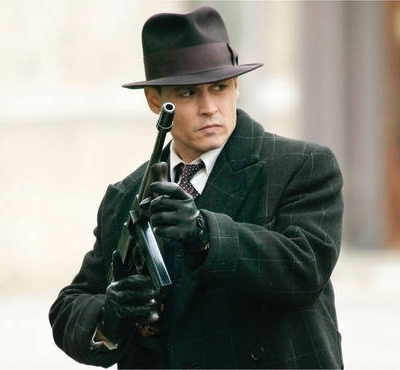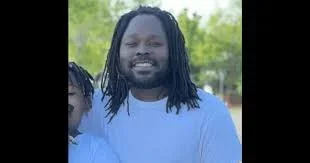Public Enemies: Persimmon Pudding
/Year Released: 2009
Directed by: Michael Mann
Starring: Johnny Depp, Christian Bale, Marion Cotillard
(R, 143 min.)

"OK, boys; let's go make a withdrawal." John Dillinger
Johnny Depp shines in his portrayal of romanticized bank robber John Dillinger, his smile just as disarming as his tommy gun. And the midnight shootout in the hush woods of Wisconsin evokes some fond memories of Midwest Fourth of July fireworks. But the rest is rather lackluster, with a script that paints some of the most colorful thugs of the era with the gray tones of a Sunday obituary for the local dentist.
Based on Bryan Burrough’s Public Enemies: American’s Greatest Crime Wave and the Birth of the FBI, 1933-34, the film strives to be historically accurate to a fault. The famous jailbreak scene is filmed at its actual location in Crown Point, Indiana, as is the infamous midnight shootout at the Little Bohemia Lodge in Wisconsin. Chicago’s Lincoln Avenue is redone thirties style, complete with reassembled street car tracks to house the Biograph Theater, where Dillinger watched a Clark Gable gangster movie just before he was gunned down by the FBI.
Director Michael Mann eschews sentimental myth for grimmer realties, at times unveiling the brutality of both law and lawbreaker. Johnny’s gang routinely pistol whip a teller or two to get their attention, but that pales in comparison to the ruthless interrogation of Dillinger’s girl, Billie Frechette (Marion Cotillard), who emerges bruised and bloody.
Similarly, we see both Dillinger (Johnny Depp) and FBI Director J. Edgar Hoover (Billy Crudup) perform for the press. The Bureau Chief calms the public with a well-rehearsed speech, but he lacks the spontaneous wit of the bank robber.
Captured and brought back to an Indiana jail, Dillinger refuses to bow his head in defeat, and goes back and forth with the press as he is ushered into captivity. His brief nod and wave to the throngs who line the street at his capture has the regal restraint of a monarch. He robs banks but refuses to take the pocket change offered by transfixed bystanders: "That's your money, mister. We're here for the bank's money, not yours. Put it away." And these well-publicized Robin Hood antics have all the cunning of a born politician. If only Dillinger would have run for office, he would have been able to rob banks legally, and probably lived into well-pensioned old age on the taxpayer dime.
Yet for all his roguish charm, Depp’s Dillinger never gets truly under our skin. We grimace but do not mourn when he is betrayed and gunned down on a Chicago street. Some critics see this as an artistic choice to avoid sentimental pandering, purposely rendering Dillinger “an efficient, disciplined, bold, violent man, driven by compulsions the film wisely declines to explain,” as Roger Ebert maintains. I’m not so sure.
So too with his Nemsis, Melvin Purvis (Christian Bale) the G-Man in relentless pursuit of Dillinger and supposedly the reality behind the invention of cartoon character Dick Tracy. Sadly enough, Bale seems to have morphed into the robotic / carton creations behind his most publicized roles, and his wooden, square-jawed and humorless Purvis is unremarkable. How much blame belongs to a script that fails to explore character is the question.
The romance between Dillinger and the half French hatcheck girl Billie also lacks sizzle. Sure, Dillinger is infatuated with her, but she seems oddly passive, deliberately weighing his offer of permanently checking out of the hat check desk before she finally opts to go with him. The pillow talk is certainly not in depth -- “I like baseball, movies, good clothes, fast cars... and you. What else you need to know?” – and probably that’s the way it was with this man addicted to risk rather than self-analysis, but it doesn’t provide good theater.
And as impressive as the period details are, they have more of a Masterpiece Theater polish than the raw, dust streaked American Depression that produced Dillinger and made him legend. As Lou Lumenick so accurately states:
You would hardly know the Great Depression has hit its depths for all the fancy costumes and the shiny cars, all of which look like they've just been driven off the lot. That makes it hard to understand why Dillinger became a hero in some quarters for robbing banks -- all are imposingly grand here, in contrast to the small-town banks Dillinger favored for his real-life exploits.
Some of the film that bows down to history is doomed by it, though. Purvis and the FBI pursue Dillinger with plodding persistence, dogged, inept at times, but probably the way it actually happened in the real world. The movie going public wants a little panache here. A little emotion from Purvis, some rage and incautious remarks to seep from his tight lips, maybe even a fist pounded into onto his desk, a hand raked through his perfect hair. A little more trash talk to the captive when he talks to him behind bars rather than the uninspired, “The only way you're walking out of this jail cell is when we take you out to execute you.”
In contrast, one scene apparently based on truth has all the drama Hollywood could ever dream up. It’s a lazy afternoon with most of the Chicago cops out setting up their trap for Dillinger, who is about to be betrayed that evening. Depp walks into the Chicago Police Headquarters and wanders around until he finds the office with “Dillinger Bureau” printed on its glass pane. He takes a slow sauntering stroll through, glancing at the pictures of himself and the gallery of his cohorts, most of them marked “deceased.” Just before leaving, he turns to the lesser police hacks gathered around the radio listening to the Cubs game. “What’s the score?” he throws out, with the steel nerves of man who lives for risk, gets high on it.
It’s these moments you remember, not the flashing tommy guns and the blood drenched farewells.
—Kathy Borich

Film-Loving Foodie
Much of the film centers on Chicago, where Dillinger feels safe with his gangster connections. He wears tailored suits and eats at the best restaurants, treating Billie Frechette to a dinner she might only have dreamed of before, champagne and thick juicy steak fresh from the Chicago stockyards.
But I’m going to ignore that posh dinner and go back to Dillinger’s native Indiana, where his father was a grocer by trade. Having gone to Indiana University in Bloomington, as well as living and teaching there for a few years, I well remember some Hoosier specialties.
One of them is persimmon pudding, made from the tangy fruit that grows well there. I’m sure you will enjoy this unique taste.
Here are few more tastes of Indiana and my native Chicago:
Italian Beef and Eggplant Parmesan
Ring of Fire Biscuits from Nashville, Indiana
Enjoy!
Persimmon Pudding
“Southern Indiana Hoosiers guard the locations of persimmon trees like they guard where they find morels,” which are delicious local mushrooms. (I remember my students from the K-12 school where I taught in rural southern Indiana would go mushroom hunting, and once they brought me some of their finds. I deliberately waited a few days before preparing them, and then when no one turned up dead or poisoned, I cooked mine up.)
Ingredients
2 c. persimmon pulp (see the end of the recipe)
2 c. sugar
2 large eggs, beaten
1 t. soda
1 1/2 c. buttermilk
pinch of salt
1/2 t. cinnamon
1 t. vanilla extract
1/4 c. cream
1/2 stick butter
1 1/2 c. flour
1 t. baking powder
Directions
Preheat oven to 325.
Beat pulp, sugar, and eggs until thoroughly blended. Add the soda to the buttermilk and stir until the foaming stops. Blend into pulp mixture, then mix in flour, vanilla, cinnamon, baking powder, and salt. Stir in the cream.
Melt the butter in a 13x9x2 baking pan, swirl to coat pan (you know, like making cornbread), then pour the butter into the batter and mix well. Pour the batter into the pan and bake about 45 minutes, until set.
This is not a cake. If it doesn't fall on its own (it should), drop the pan a couple of times. Serve with whipped cream.
ABOUT PERSIMMONS: You can buy Japanese persimmons in supermarkets, mostly grown in California. They're about the size of a large plum. There are two general types of Japanese persimmon: The "hard" persimmons, that can be sliced, and the "soft" persimmons, that cannot and are pulped. The fuyu is one of the latter, and is often found in produce departments of larger supermarkets.
All Japanese persimmon types are inferior to the American persimmon (Diospyros virginiana), whose fruits are much smaller and quite intense in flavor. As far as I know, nobody outside Indiana even knows the American persimmon exists, much less cultivates the fruit. You can use fuyus from the store (buy only very soft fruits, and pulp them in a food mill), or you can find American persimmon pulp (Dillman Farms in Indiana sells it here: http://www.dillmanfarm.com/ or you can google persimmon pulp and see what you find. If you have a persimmon tree or know where there are some, wait until the first frost to harvest, or the persimmons will be so tart you'll pucker for a week.) The American persimmon will give you far superior results to the fuyu, which isn't as flavorful.
Recipe Source: Group Recipes.com















